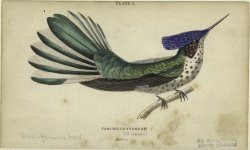I had yet another look at the unknown Mr Stokes, in (the invalid) "
Trochilus Stokesii", a k a Stokes's Hummingbird, and came up with the following:
Maybe King offered "
Trochilus Stokesii" (in 1831), not only as gesture of a respect of a sadly deceased leader/friend/colleague/Mariner, but (also) as a mere favour (a service) in return ... !?
In the first volume of the Classic book:
Narrative of the surveying voyages of His Majesty's Ships Adventure and Beagle (
between the years 1826 and 1836, describing their examination of the southern shores of South America, and the Beagle's circumnavigation of the globe), by P. P. King and Charles Darwin, we find the following short note, by King, made in March 1828:
A humming-bird had been seen at Port Gallant last year, and was brought to me by Captain Stokes, since which none had been noticed. Here, however, we saw, and procured several; but of only one species.*
[Here, the footnote(*) telling us that this bird was described by Vigors (1927) as 'Mellisuga Kingii'.]
A few months later Captain Stokes had shot himself (p.153).
I assume the foot-note above was in reference to p.71 (
here) from January 1827, which (in its turn), also have a foot-note (*), saying:
* One of the feathered tribe, which a naturalist would not expect to find here, a ' humming bird,' was shot near the beach by a young mid-shipman.—Stokes MS.
And, note that except for Captain Pringle Stokes (Commander and Surveyor), we also find another "Mr. Stokes" onboard the
Beagle, a guy who continued to help King collecting, even onwards, through the whole voyage, long after the unfortunate End of Captain Stokes (which, most likely, would be the Midshipsman; 'J. L. Stokes', listed among the Crew, on p. xii).
Also see p.578, again dealing with
'Mellisuga Kingii' (in yet another foot-note).
More details of the unfortunate End of Captain (Pringle) Stokes (1793–1828) is told on his Wikipedia page (
here).
He's not to be confused with the far younger (apparently all unrelated)
John Lort Stokes (1811–1885), who also served onboard the
HMS Beagle (his Wikipedia page,
here), who (on the other hand!) very well could be (and I think he actually is/was) the mentioned "J. L. Stokes" above. I have a hunch he's not easy to brush aside, not that irrelevant (as suggested by Laurent, in post #2, from back in 2014) ... which (I assume?) led to, or was the very reason for (alt. the starting point) that ended up in him being deleted/erased completely from (the
stokesii entry in) the
HBW Alive Key.
Of course, it would be very interesting to find out who's MS it was, in the short reference (above): "Stokes MS."... ?
To me, this far, either one of the two guys onboard the
HMS Beagle (Captain P. Stokes, and Mr J. L. Stokes)
could be the dedicatee (from/in 1831). At least they are both equally possible dedicatees (and as such I think they both should be kept in the loop), together with the stockbroker/naturalist Charles Stokes (1783–1853), of course. This far, I think all three of them ought to be kept in this equation, as possibilities, as more or less likely candidates.
In my mind, the most likely dedicatee would be Stokes, either one, aboard the
Beagle. Actually, I wouldn't be surprised if it turns out that the
Dictionary of Scientific Bird Names (from 2010) was perfectly correct.
For whatever it's worth.
We'll see ... (if time allows, probably not).
Björn
PS. Neither one of those guys (nor this certain Hummingbird) are mentioned is my own MS, thus I haven't searched for (or researched) any of them, not at any serious depth (not more than what's been shown in this thread), and certainly not thoroughly enough to tell either way.







